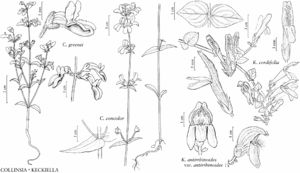Collinsia greenei
Proc. Amer. Acad. Arts 10: 75. 1874.
Annuals 10–30 cm. Stems erect to ascending. Leaf blades narrowly lanceolate to ovate or oblanceolate, margins entire or serrate. Inflorescences glandular; nodes 1–5-flowered; flowers crowded or not; distalmost bracts linear, 2–3 mm. Pedicels ascending to spreading, proximalmost sometimes longer than calyx, distalmost equal to or shorter than calyx, visible or not. Flowers: calyx lobes lanceolate to ovate, surpassing capsule, ape× subacute to rounded; corolla ± uniformly dark purple, rarely pale pinkish purple, 10–15 mm, sparsely glandular; banner length 0.5 times wings, base with 2-crested, crescent-shaped folds extending 1–1.5 mm from throat opening; stamens: filaments glabrous, adaxials sometimes hairy, basal spur 0. Seeds 2–4, oval, 2–3 mm, margins thin, not inrolled. 2n = 14.
Phenology: Flowering Apr–Jul(–Aug).
Habitat: Open chaparral or coniferous forests, serpentine slopes.
Elevation: 300–2500 m.
Discussion
Collinsia greenei occurs on ophiolites, most frequently on soil derived from serpentinite and similarly altered ultramafic rock. Within its range, only C. rattanii occurs on these substrates; C. latifolia, C. parviflora, and C. wrightii are not on highly mafic soil.
The dark, nearly uniformly purple corollas of Collinsia greenei are distinctive, and the crescent-shaped flap of tissue on the adaxial lobes is unique. Other taxa have folds that bulge outward but are neither doubly crested nor crescent-shaped.
Selected References
None.
